The Problem: Tree Swallows may prevent establishment of new Purple Martin colonies.
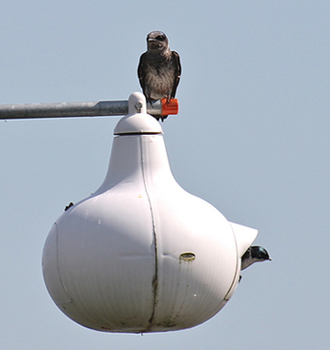
You may meet persons hoping to establish colonies of Purple Martins who complain Tree Swallows are interfering with their plans. This page should help you direct them to online resources for reducing competition between Purple Martins and Tree Swallows. But before discussing this subject we’ll give you some Purple Martin background. The photo above by Cathie Westcot shows a perching female Purple Martin and a Tree Swallow peeking out of a martin “gourd” house.
Don’t be fooled by their name – Purple Martins are swallows. The term “martin” comes from England, where swallows with short squared or notched tails are traditionally called martins, as opposed to long-tailed “swallows.”
Purple Martins are our largest swallows by far. They weigh nearly three times as much as Tree Swallows (56 gm. average as opposed to 20 gm.). The bird on the left below is a male martin in all-dark full adult plumage. At right is an adult female.
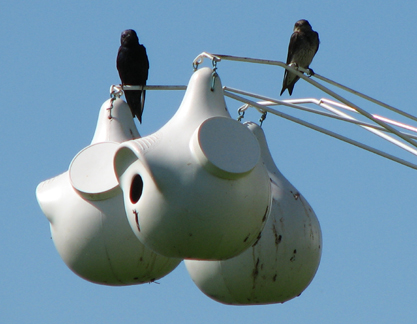
Where do Purple Martins nest?
Like Tree Swallows, Purple Martins are obligate secondary cavity-nesters. They must nest in cavities but are unable to make their own. Under original (pre-human) conditions Purple Martins probably relied on woodpecker holes and natural cavities in large trees and cactus plants. Martins still use these sites occasionally in Mexico, and rarely in the United States and Canada west of the Rockies. However, martins in eastern North America nest exclusively now in apartment houses and gourds provided by people. And as with Bluebirds, a large and dedicated hobbyist movement has grown up dedicated to attracting and conserving Purple Martins.
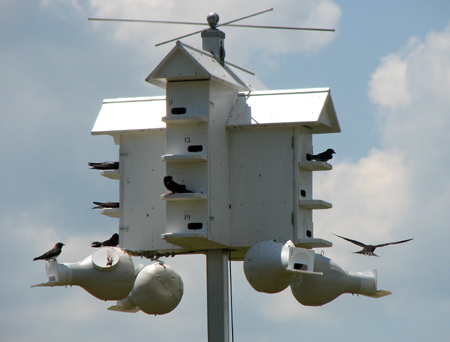
What are Purple Martin population trends?
Human-managed Purple Martin colonies, some with hundreds of nesting pairs, have dramatically increased martin numbers from the pre-human days when they probably nested in isolated pairs or small groups. However, in 2021 Partners in Flight’s Avian Conservation Assessment Database Scores estimated the Purple Martin population was 9,300,000, down significantly since 1970. (Tree Swallow numbers decreased 40% during the same period). And, also in 2021, Partners in Flight rated Purple Martin a species of “Moderate Concern.” Martins received a score of 10 on a scale of 4-20, where higher numbers indicate more concern. The Tree Swallow score was also 10.
What are some possible reasons martins use concentrated housing today?
Why have eastern martins switched to such an unnatural mode of nesting? One factor may be that “martin house” nesting opportunities now vastly outnumber the old, hole-filled tree snags where martins once nested. Plus, cavity concentrations favor certain martin behaviors, especially the willingness of older, experienced males to permit younger males to settle nearby. This gives the older males opportunities to father more young by copulating with the younger martins’ mates.
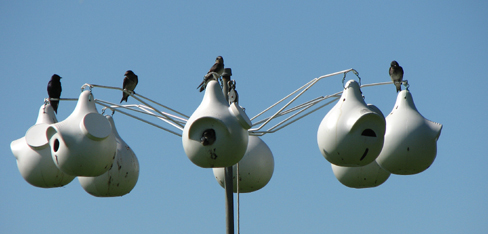
Does Purple Martin housing attract other birds?
Concentrations of cavities put out for Purple Martins do attract other cavity nesting species. Starlings, House Sparrows, Bluebirds, and Tree Swallows all view martin apartments and gourds as potential homes. These species usually begin claiming sites before martins arrive in spring, and will defend their nest and surrounding compartments against young martins prospecting for new homes. The photo below by David King shows a Tree Swallow (far left gourd, its small head barely visible peeking out), an Eastern Bluebird, and a pair of Purple Martins, all wishing to nest in this group of gourds.
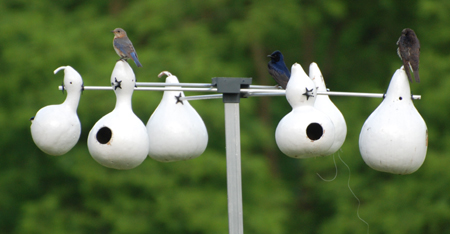
What problems do the competing species cause for Purple Martin hobbyists?
These four martin competitors pose different levels of problems for martin lovers. Starlings and House Sparrows harass and drive away adult martins, break their eggs and kill their young. However, both starlings and House Sparrows are unprotected non-native birds. Therefore, hobbyists can prevent them from nesting and even kill them if need be.
On the other hand, Bluebirds and Tree Swallows are native birds protected by law. People can’t interfere with or destroy their active nests. Luckily, these species do not destroy martin eggs and young. And bluebird or Tree Swallow pairs that try to nest in well-established Purple Martin colonies are normally dominated easily and evicted by returning martins, usually older, experienced breeders.
However, Bluebirds or Tree Swallow that begin nesting in one compartment of a new or unestablished Purple Martin site will try to defend the entire housing complex against other birds. This discourages Purple Martin “scouts”, often young, inexperienced birds, from settling at these new locales. The “wrong swallow” has claimed an entire martin apartment house for itself in Ryan Bloom’s photo, below.
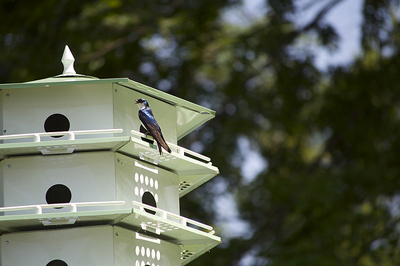
The Solution for reducing Purple Martin – Tree Swallow competition? Follow the protocol below.
Over the years Purple Martin enthusiasts have developed some effective techniques for reducing competition from native species. The Purple Martin Conservation Association web site offers excellent information. And there are several other good online resources for reducing competition between Bluebirds and Tree Swallows and Purple Martins.
The consensus is that both Bluebirds and Tree Swallows must be prevented from settling in new or unestablished martin houses. If these non-target species are starting to nest, all martin compartments must be closed at once or the houses completely removed temporarily. Then a single nest box built to the smaller birds’ specifications must be erected no more than 25′ to 35′ away from the martin site (see below), with its entrance facing the martin houses. Allow the pair of Bluebirds or swallows occupy this box. Don’t reopen Martin housing until Bluebirds or swallows are nest building and egg laying in their own separate box. These committed Bluebirds or swallows will then prevent others of their own kind from claiming the nearby reopened martin compartments, which they consider within their own territorial space.
Click here for a much more detailed protocol for reducing competition between Tree Swallows, Bluebirds and Purple Martins. Use it when you’re trying to establish a new Purple Martin colony.
The two examples below show boxes for Bluebirds or Tree Swallows placed near Purple Martin colonies to reduce competition. The first is at Doug Smith’s colony in New York. The second, in Charlie Kelley’s photo, is in Alabama.
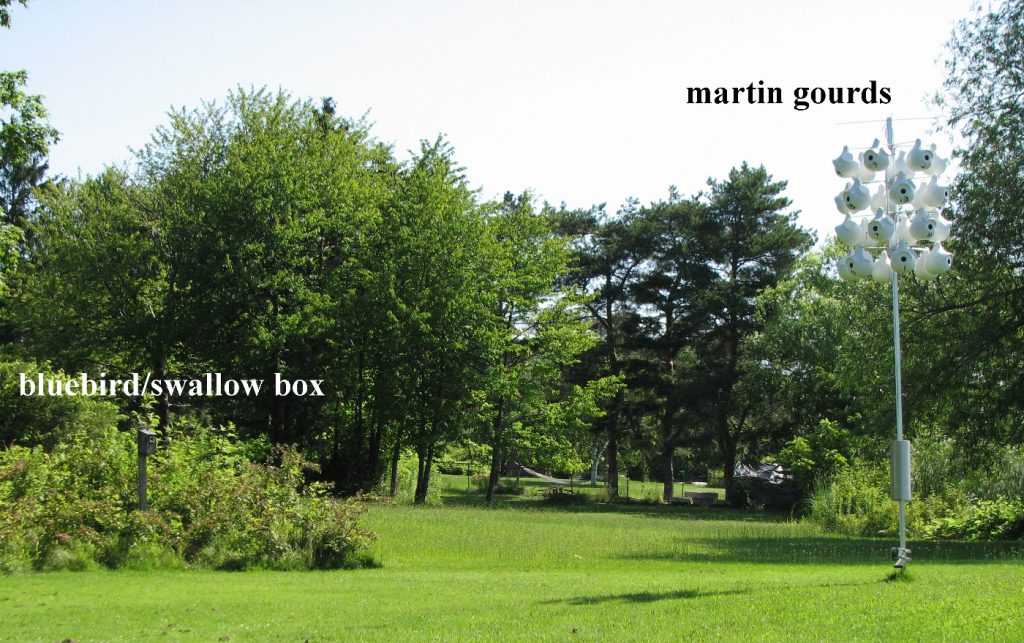
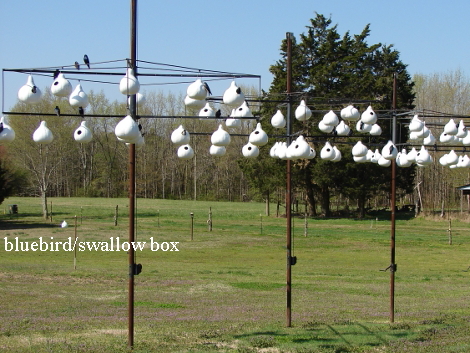
So, are you a martin lover, frustrated because the “wrong swallows” or Bluebirds are dominating your new martin housing complexes? If so, use the procedure above or contact one of the many martin hobbyist groups or online forums for advice.
And if you find both Tree Swallows and Bluebirds are interested in your martin houses try “pairing” two swallow/bluebird boxes 5-10 feet apart from each other, with the box pair 25-35 feet away from the martin compartments. You might hit the jackpot and have all three great native species nest!
Click here for a page with more information on reducing competition by pairing boxes for Tree Swallows and Bluebirds.
——————————————————————————
Home: Tree Swallow Nest Box Projects
Creating Tree Swallow Nest Box Projects
Spring Return
Nesting Season Behavior
Song and Calls
Nest Site Claiming
Pair Formation
Nest Building
Bird Flight
Mating and Paternity
Diary of One Season at Salmon Creek
Monitoring Nest Boxes and Keeping Records
Making Box Checks Keeping Box Records Control Sheets Season Summaries Print Sheets
Banding Your Tree Swallows Banding Adults Banding Nestlings
Tree Swallows in Research Research Bibliography Glossary of Terms